JAXA Astronaut Activity Report, April, 2013
Last Updated: June 19, 2013
This is JAXA's Japanese astronaut primary activity report for April, 2013.
Long-duration ISS mission training of astronaut Koichi Wakata
Astronaut Koichi Wakata, a long-duration crewmember of the 38/39 Expedition Mission to the International Space Station (ISS), visited the European Astronaut Centre (EAC) of the European Space Agency (ESA) in Germany and the Gagarin Cosmonaut Training Center (GCTC) in Russia, for a long-duration ISS mission training.
Astronaut Wakata received training to operate the Columbus laboratory module and the Automated Transfer Vehicle (ATV) at the EAC in Germany, along with his long-duration ISS crewmate NASA astronaut Richard Mastracchio between April 9 and 11.
Their training on Columbus included verification of operational and exchange methods of the system hardware and experimental equipments; ATV training included verification of mission events from launch to reentry after completion and vehicle's overview, response to fire or sudden depressurization during ISS docking, and transfer of cargo between ATV and the ISS.
In late April, Astronaut Wakata participated in the final preflight training as a backup crew member of the Soyuz TMA-09M spacecraft (35S) at the Gagarin Cosmonaut Training Center (GCTC) in Russia, where he received intensive training on the Russian module of the ISS and the Soyuz spacecraft.
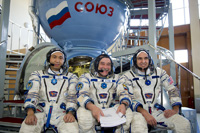
Astronaut Wakata and backup crew members receive the final examination (Credit: JAXA/GCTC)
Astronaut Wakata and the backup crew received the final examination at the end of the training along with the 35S prime crew on April 25.
The examination was conducted separately on the prime and backup crews using simulators, which tested for their ability to continue the operation in response to various contingencies during simulations of the ISS Russian module and Soyuz spacecraft launching to docking operations.
During the simulation test of the ISS docking operation six hours after the Soyuz spacecraft launch (four-orbit rendezvous), the astronauts’ ability to safely perform manual docking to the ISS in response to contingencies such as communication system with ground control and air purification system failures were tested.
During the simulation test of the ISS Russian module operation which lasted over eight hours, their ability to respond to contingencies such as sudden depressurization was tested.
Both prime and backup crews passed the simulation examinations and were officially certified as the Soyuz TMA-09M spacecraft crews. The Soyuz TMA-09M spacecraft carrying the 35S crew was launched on May 29, Japan time.
Long-duration ISS mission training of astronaut Kimiya Yui
Astronaut Kimiya Yui, who was assigned as a long-duration crew member for the ISS Expedition 44/45 mission, continues training for his upcoming long-duration ISS mission.
Astronaut Yui relocated from the U.S. to Russia in late March, and received training on attitude control and orbital maneuvering system of the Soyuz spacecraft at the GCTC in April. Through lectures and simulation training, he deepened his knowledge and techniques of crew operations during attitude and orbital changes under ever-changing conditions.
Astronauts Takuya Onishi and Norishige Kanai receive training for the Japanese Experiment Module “Kibo”
Astronauts Takuya Onishi and Norishige Kanai conducted training for the Japanese Experiment Module “Kibo” at the Tsukuba Space Center (TKSC) between April 15 and 18.
Their training focused on the Japanese Experiment Module Remote Manipulator System (JEMRMS), in order to be certified as JEMRMS Specialists on “Kibo”. During training on how to respond to JEMRMS failure, they learned the appropriate techniques to isolate and restore the source of the failure, and gained evaluation skills to continue operation of the JEMRMS under limited function due to failure.
Prior to this training, astronaut Onishi became familiarized with the camera that provides visual support during JEMRMS operation during training under normal conditions.
In addition, he gained the knowledge and techniques to operate Kibo's Airlock and the Equipment Exchange Unit (EEU).
Both astronauts were certified as JEMRMS Specialists after passing the examination designed to assess their skills at the end of their training period.
In addition to the JEMRMS training, astronaut Onishi learned an overview of the experimental payloads used on “Kibo”.
Astronaut Akihiko Hoshide gives a presentation of his missions during a visit to his alma mater Meikei High School
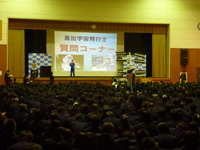
Presentation at Meikei High School (Credit: JAXA)
Astronaut Akihiko Hoshide visited his alma mater Meikei High School in Tsukuba City, Ibaraki Prefecture and gave a presentation of his long-duration ISS mission.
Astronaut Hoshide introduced his mission using video images, and answered questions from the students.
Students asked a wide variety of questions about the universe that are beyond the scope of manned space exploration, such as “is there and end to the universe” and “are there living creatures in space”, as well as questions related to their future aspirations such as “what efforts did he make to become an astronaut” and “what were his motivations to realize his dream”.
In response to the question about his motivation to become an astronaut, Hoshide answered “I thought that learning English and becoming internationally-minded would be essential, so I went to study abroad when I was a high school junior. Even though I failed the astronaut candidate selection exam three times, I did not give up and continued to try.”
After answering the student’s questions, astronaut Hoshide took a photo with students whom he had maintained communication via the ARISS (Amateur Radio on the International Space Station) school contact while onboard the ISS. At the end of his visit, he planted a cherry tree with the students in the student residence hall’s garden, where he used to live during his school years.
Lecture held by astronaut Takuya Onishi at the TKSC’s open house event
Astronaut Takuya Onishi held lectures to the general public in the open house event at the Tsukuba Science Center (TKSC) Special Exhibit during the Science & Technology Week on April 20.
The lecture was held three times, and he gave presentations about the ISS and the Japanese experimental facility “Kibo”, about life in space, and the unique phenomena that occur in microgravity.
Astronaut Onishi also described his previous training experiences, including weightless training aboard an aircraft, and extreme environment training at an underwater facility off the coast of Florida held for one week.
He talked about the astronaut candidate selection test, and commented that “his ability to demonstrate his skills paid off” during the final selection test held in the isolated facility that lasted for a week.
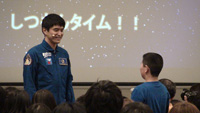
Astronaut Onishi answering questions from the children (Credit: JAXA)
During a Q&A session, numerous questions were asked about his motivation to become an astronaut, difficulties during training, and his aspirations in space.
When asked about what is important to become an astronaut, astronaut Onishi answered, "I believe that it is most important to try your hardest to overcome difficult situations. People don’t grow up when things are going well. Dealing with hardships and downfalls teaches you to grow up.”
During his last lecture, astronaut Onishi dedicated a message to the children, "Because a small country such as Japan is lacking in natural resources, the advancement of technology is important in order to stay competitive in the world. You children hold Japan’s future in your hands, and I hope that this lecture will inspire you to study science."
Lecture held by astronaut Soichi Noguchi at the workshop for the Sochi Winter Olympics
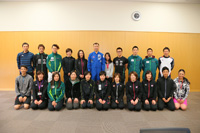
Photograph taken after the lecture (Credit: Aflo)
On April 21, astronaut Soichi Noguchi was invited to "The Building up Team Japan 2013 for Sochi," a workshop held by the Japanese Olympic Committee (JOC) for the Sochi Winter Olympics in 2014, and gave a presentation to the Japanese representative athletes.
At the workshop, astronaut Noguchi explained the mission events of the Soyuz spacecraft from its launch to its return to Earth, and answered questions from the athletes.
He described his mental state during training under time-constrained emergency situations, where he was able to perform the task without rushing and pace himself by thinking "slower is faster". The athletes had never met an astronaut before, and listened to the astronauts' job and training descriptions with great interest.
New Astronauts at the Front-Line

This month was completely taken up with Soyuz training in Russia. When I am training at Star City, my family is not with me so I can totally concentrate on my training. It is very difficult for my family as they are without a father for long periods of time. However, if I don’t put all my energy into training, I am not able to acquire extensive knowledge and technical skills so this is an optimum training environment for me. To be honest, the orbit/attitude control subjects that I am studying during this training session are some of the most difficult subjects and I have heard people joking that ‘you shouldn’t get married if you can’t pass this exam!’ I think a lot of other professions are the same but, the cooperation of your family is essential if you want to try to do a good job in general. Let’s not forget to be grateful to our families.
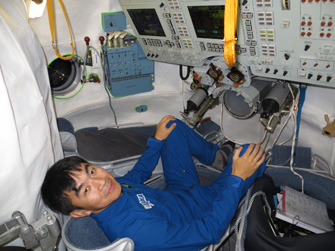
When I am doing Soyuz training, I remember my pilot training in U.S.A. and I feel instantly rejuvenated! I am happy that my 43 year old self is still challenging itself in the same way as it did when I was 23 and I am grateful to have such an opportunity. (Photo credit: JAXA/GCTC)
Anyway, this time I would like to tell you a little about how I have come to realize that happiness means different things to different people in my conversations with various Russians I have met.
Russian people seem to have a very good impression of Japanese people and, in particular, there are many people who admire Japanese industriousness. It’s a little strange to me saying this since I am Japanese but, in reality, I think that the Japanese people around me really do work hard. There are a lot of Russian people who praise me for how much I study but I always tell them that other Japanese people work harder than I do. When I am in flight training, I have time to sleep properly and it’s not like I have to sleep in a sleeping bag so I am not working as hard as I used to. Once I have explained this, some people don’t seem to be able to comprehend why someone would work so hard and ask serious questions such as ‘What is the purpose of a life like that?’ or ‘Are you happy with a life like that?’ I have talked about this before but the happiness which is my life’s goal is to make a contribution that benefits a lot of other people, so, for that reason, I am happy no matter how much I have to work. On the other hand, if I concentrate too much on work, I neglect my family and my family’s discontent builds up (particularly my wife’s). That is where opinions are divided – do I focus my attention on my work or on my family?
In actual fact, even in conversation in Russia, there have been people who say that I am working so hard for the benefit of my family and the benefit of the work in general so if my family loves me, they should be able to put up with it! There are other people with the opinion that there is no point in working if you have no time to spend with your family and that neglecting your family is getting your priorities all wrong! And I thought that despite the differences between national characters or between men and women, people all have different opinions and each of these people has a different idea of happiness. This is, of course, perfectly natural and I think that, in the end, maybe the key to most people’s happiness is respecting the attitude of each person and not imposing your own attitude on other people. It might be important for those who are planning on getting married and founding a family or those who have already founded one to take the time to really talk things through and understand each other’s attitudes. If you don’t know your partner very well, your consideration for them will become complacent in the end and your feelings will not be understood.
To change the subject a little, recently, I have been acutely feeling the difficulty of building relationships of mutual trust with other countries while observing the environment surrounding Japan. If we think about it calmly, we can see that a bright future will not be born out of hatred but maybe humans tend to prioritise direct benefits no matter what for things that mean something to them personally such as their own position or organization. However, when I look at the astronauts who are senior to me, I get the impression that there are many who transcend trivial disputes, of course, but also more serious disputes between countries, etc. There is a special significance in the fact that humans go into space and it may be that this is an important step in the progress of humankind to a new level not only in the field of sciences but in the arts and culture as well. This is how I, having in the past seriously studied the wars that humankind has repeated throughout its long history, feel. There really might be some kind of truth in this…when I go into space, I want to work even harder so that I am able to tell you about that kind of experience and my impressions as well as contributing to a world in which as many people as possible can live happily!
Just like last time, this blog has ended up not really being about space. Next time, I will write something about it so I hope you will look forward to it.
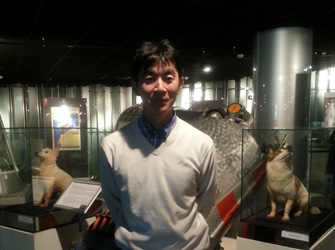
A change of pace for me in Moscow at the weekend – do you know who the dogs on either side of me are? They are Belka and Strelka, the first earth-born creatures to go into orbit and return alive. It turns out that they were originally stray dogs. It seems that they were chosen from among many dogs for their obedience and cuteness taking the media as well as the space flight into consideration. (Well, that’s what I was able to understand from a Russian language documentary that I watched…) (Photo supplied by: JAXA)

I would like to say a big thank you to all those who came to the Tsukuba Space Center Open Day on the 20th April, even though it was quite chilly!
My trip home to Japan to train on the Kibo robot arm and experimental devices coincided with this open day and I was blessed with the opportunity to give a lecture but, to be honest, I am not yet used to giving lectures and I was very nervous. This is because, so far, for the most part, it has been the three of us new astronauts who have attended these events together and I have almost never had the chance to do it alone. In a manner of speaking, it’s like a musician who has always been in a band suddenly going solo. The extent of the loneliness is quite considerable.
On top of that, the schedule on the day was totally full, right down to the last minute with three lectures in addition to a number of interviews and participation in other events. When I first saw the itinerary, I was stunned.
So it was an open day that started with a fair sense of anxiety on my part but once the events started, they were fun! After all, it’s good to have an opportunity to actually communicate directly with everyone.
In the Q&A sessions, I was happy that I was able to answer, to the best of my ability, the various questions that everyone had. In particular, some of the children’s questions were unique and this made it even more fun.
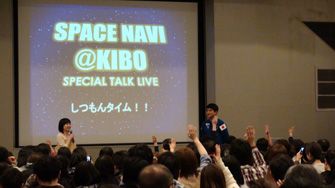
From the point of view of the person answering the questions in these Q&A sessions, it is pretty hard work and you have to instantly compose an answer in your head but when there is a difficult question, I sometimes start talking and my brain is whirring away at the same time, organizing my thoughts. And when that happens, my words get all jumbled and my answer becomes irrelevant and incoherent and I am constantly reflecting on this afterwards. I feel that sifting through and arranging your own opinions on a regular basis is a very important thing.
Incidentally, there was a moment in one of the lectures that brought me out in a cold sweat.
I think it was during the Q&A session in my third lecture that, when I was taking questions from everyone, a young boy put up his hand.
Realising he had been chosen to ask his question, the boy got a little nervous and hesitated before finally opening his mouth and asking,
“What happens when you break wind in space?”
…I was completely taken by surprise.
I was taken by surprise by the gap between the large-scale scientific word “space” and the physiological phenomenon of “breaking wind” that we humans find humorous in a sense.
It is a simple, innocent question but for me, who has not yet spent any time in space, it was a difficult question to answer. At any rate, it’s not something that they teach you in training. So there was nothing for it but to answer with the knowledge that I have. I was frantically searching for an answer inside my head.
At the time, I decided that breaking wind = smells and so I re-phrased the question to ‘What do we do about smells in space? (This took about 5 seconds.)
In this way, I was able to think of this innocent question as an astute point about the characteristics of actual life in a state of weightlessness in space.
On the earth, the air around us is always moving. One of the reasons for this is the existence of thermal convection in which warm air is light so it rises and cold air is heavy so it sinks. This is caused by gravity. In a state of weightlessness, as thermal convection does not work, there is less air circulation than on earth. I can go as far as saying that if you stay in one place for a long period of time, the carbon dioxide that you exhale can build up around you and you will be short of oxygen.
For this reason, the space station has a number of fans that forcibly circulated the air (much like an electric fan). Air circulation in a zero gravity environment is extremely important.
I don’t know if the boy who asked the question had any knowledge of this. However, it is a fact that this simple, innocent question has hit on the essence of a particular subject. I touched on the importance of the air circulation system on the space station and told the boy to be very careful of spreading smells in space as they stay around for much longer than they do on earth! Internally, I was in a cold sweat!
The lecture ended without any problems but this story is not yet over.
Once my training and all the events in Japan were finished, I thought back over the open day on the plane on the way back to Houston. And when I remembered that boy’s question, I realised that I might have spectacularly misunderstood!
This misunderstanding was that breaking wind = smells.
However, there is an aspect of breaking wind that must not be forgotten when thinking about this from a physical point of view. This is that breaking wind = a jet of gas from inside the body.
When I realized that, I was astonished. Maybe that boy had wanted to ask whether the body moved in reaction to breaking wind in a zero gravity environment!
You know, the images of flying under “your own steam” that you see in comics.
I won’t ever be able to find out the true intention of the boy’s question but I think I should consider this issue further.
Theoretically, a reaction should occur if there is any kind of jet of gas. However, it would seem to be necessary to break down the orientation of the body’s centre of gravity and the perpendicular component to that. In that case, in the component of the orientation of the centre of gravity of actual propulsive power, one more component may be the creation of the moment that rotates the body centring on the centre of gravity. Therefore, in order to obtain the most effective propulsive force, it may be necessary to eject the “gas” straight in a direction away from the body’s centre of gravity…(the rest is omitted).
Hmmm. I could probably write a whole thesis on this. I was so flummoxed that one day when I met my senior colleague Mr Furukawa at the gym, I boldly decided to ask him.
Me: Mr Furukawa, can I ask you something a bit odd?
Mr Furukawa: (smiling) Sure. Go ahead. You can ask me anything.
Me: So, the other day at the open day, this happened and that happened and someone asked me if your body would move if you broke wind in space.
Mr Furukawa: (still smiling) Ah yes. I have researched that in the past (what?) and it would only be possible if it was a fairly big jet of “gas”. You don’t feel any reaction in reality.
Me: Oh, I see. I guess that’s what I thought. Is it because there is too big a difference between the mass of the body and the gas?
Mr Furukawa: Yes, that’s right. It’s surprisingly difficult to move a body. For example, if you try swimming breaststroke in mid-air and push the air away from you, you really only progress very slowly.
Me: That makes sense. You’ve answered my question. Thanks very much!
It seems that I wasn’t wrong theoretically but what can be done if the mass of wind is too small? It seems like there is not enough propulsion to be able to experience it in reality. (Mr Furukawa. Thank you so much for your willing reply to my question out of the blue.)
So, what do you think? Don’t you think there are a lot of cases in which adults can learn from the child’s point of view?
*Photo supplied by JAXA

Hello everyone. This is Norishige Kanai.
Up until now I have been learning about International Space Station systems at training for two years as an astronaut candidate and then a further year or so of special training in countries that are participating in the space station, including Russia, but my astronaut training is still set to continue.
It is not only lectures in classrooms or practical training with models or simulators or in actual aircraft, there are also things that wouldn’t be called training as such like gathering information by attending various conferences as a member of the NASA astronaut corps, verifying procedures so that the crew in orbit can carry out scientific experiments and participating in and supporting controller simulations. These are all activities that accumulate valuable experience for the future.
This time I would like to talk about controller simulation.
The International Space Station works on a round-the-clock 24/7/365 basis and is controlled by mission control centres around the world. The leading role in these control centres are the controller teams who are selected from each country led by the flight director.
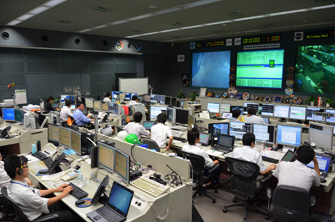
This is the Kibo control room in operation. These people watch over the Kibo space station on a 24/7/365 basis. (Photo supplied by: JAXA)
Controllers work one of three shifts a day to continuously control the space station but in addition to their actual operational work, they are always undergoing training, polishing their skills in order to be able to deal with malfunctions or emergency situations and training new staff.
Incidentally, astronauts also conduct activities as part of this controller team. CapCom (Capsule Communicator), which is what the astronaut, Takuya Onishi, does, is one of these roles and represents the mission control centre in communications with astronauts in orbit.
Controllers all have different roles and if they all started talking to the astronauts about their own tasks whenever they wanted to, the situation would become untenable so there is one controller who is solely responsible for communication. Historically, it was customary for the people responsible for communication to be astronauts who had undergone similar training and who had similar experience but in the age of the space station, CapComs do all sorts of jobs other than astronaut.
Incidentally, I have not done any CapCom training so I have not had any direct contact with the operation of the space station. I have only performed the role of a crew member in controller training simulations.
Incidentally, I have not done any CapCom training so I have not had any direct contact with the operation of the space station. I have only performed the role of a crew member in controller training simulations.
Meanwhile, the instructor team that is administering the training operates the simulator from a different building and creates various malfunctions in the “virtual” space station for training purposes.
People like me who are playing the role of the crew are holed up in a mock-up in a room right next to the instructors and we act like astronauts carrying out activities on the space station.
As it is training for the controllers, the astronauts also have to make a lot of mistakes (on purpose).
‘Houston. This is the space station. We have a problem.’
This is the kind of phrase you might have heard in a movie and this is how we talk to CapCom in the control room using a microphone.
‘When I was using the bathroom, the red lamp suddenly came on and it stopped working. What should I do?’
‘I am in the middle of an experiment and I just realised that I missed out a procedure. What should I do?’
‘Sorry. When I was working, the screw bent and I can’t get the panel to shut.’
Following instructions from the instructors, we report various malfunctions and mistakes one after the other.
Each time we do this CapCom replies:
‘We copy that. We will discuss it and get back to you with a procedure. Stand by.’
The crew on the space station cannot hear the exchanges between the people in the control room but the controller responsible should be checking the signals coming from the space station on the computer, looking up data in the technical documents and following the instructions of the flight director.
The training includes not only reports from the crew but also concurrently, various malfunctions such as computer transmissions stopping, devices that distribute electricity breaking and pumps stopping working that occur in places where astronauts can’t see them (or don’t notice them in the course of their normal activities) and the control room gives various commands to deal with these.
In the real world there would never be so many failures and malfunctions one after the other like that but during simulations, it’s as frenzied as a battlefield.
In the real world there would never be so many failures and malfunctions one after the other like that but during simulations, it’s as frenzied as a battlefield.
In the real world there would never be so many failures and malfunctions one after the other like that but during simulations, it’s as frenzied as a battlefield.
In reality, astronauts on the space station are really busy under the pressure of various tasks but during simulation, once a malfunction has been reported we are on standby.
‘They must be really busy in the control room at the moment…’ we say complacently.
After a while we receive a response from CapCom such as ‘This is Houston. Please take a photo of the failure in question and progress with the restoration procedure steps 4 and 5.’
Or sometimes, ‘We found an electrical fault so an alarm may go off but the control room will give a restoration command and deal with it so you don’t have to worry about it.’
‘There seems to be a coolant fluid leak. If we don’t fix it now, the system will go down so please suspend your experiment and check where the leak is right away. It is in …’ and so on.
There are also times when we adhere to the order of precedence but completely different explanations or instructions suddenly arrive.
It is the job of the instructor team to judge whether the response and instructions of the control centre are appropriate or not.
The simulator reflects the status of the space station in response to commands issued by the controllers and the instructors whisper instructions to the crew such as ‘Right. Report that you found the leak in XX in about 10 minutes. If they ask you about volume, tell them about XXcc but don’t say anything if they don’t ask.’
Each time I participate in a simulation, I experience a new scenario but I always admire the amount of work that goes into developing them.
For example, say we start with 1 of 2 attitude control computers not working due to maintenance as a pre-requisite to the simulation. Controllers must make preparations to be able to use the computer that is undergoing maintenance straight away in case the other computer stops working but there are always double or triple traps such as not being able to switch on the computer undergoing maintenance because of a separate electrical problem or not being able to send the latest data to the back-up computer because of a transmission problem.
It is not me who is being tested but I do sometimes feel sympathy for the controllers thinking, ‘Oooh, that’s nasty,’ about a particular situation.
From the standpoint of an astronaut, I really want to support the controllers in any way I can and help to operate the space station safely but almost all of the complex systems are controlled with commands from the control centre so all I can do is (1) report the current situation in the space station (during simulations, I have to say exactly what the instructors tell me) and (2) faithfully follow the instructions from CapCom (during simulations, instructors input information to the simulator).
There’s nothing I can do since it is training for the controllers.
Conversely, during astronaut training, with the pre-requisite of ‘Right now, the control centre is unable to give commands due to some problem or other’, we independently and repeatedly practice minimum procedures in order to ensure the safety of the astronauts and the space station.
You really feel how much the safe operation of the space station depends on the control centre on earth.
As I am seeing the brutal training of the controllers up close, I will be able to work with them with the utmost confidence on actual missions because I will think, ‘it’s OK to follow instructions from these people to the letter’, ‘if I tell them this information, they will be able to deal well with the situation’ or ‘they’re taking a long time to get back to me but that must be because they are developing a measure while envisaging everything to the finest detail.’
It is easy to say that the manner of the controllers’ job is ‘to expect the unexpected’ but in order to actually show this in their conduct, they must study diligently and untiringly and have confidence backed up with professionalism.
I believe that the ten lessons (below) from Gene Kranz, the legendary flight director of Apollo 13, are lessons that are significant and useful not only for controllers but also astronauts as well as for business and other work situations.
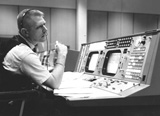
This is Gene Kranz. (Photo supplied by NASA)
- Be proactive
- Take responsibility
- Play flat-out
- Ask questions
- Test and validate all assumption
- Write it down
- Don't hide mistakes
- Know your system thoroughly
- Think ahead
- Respect your teammates












